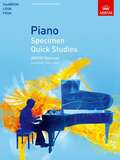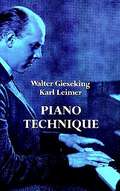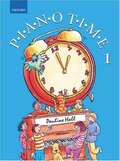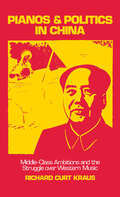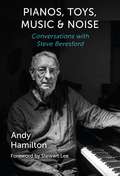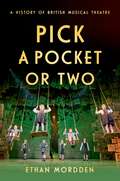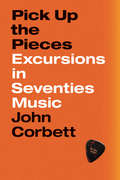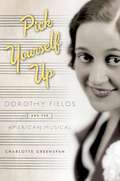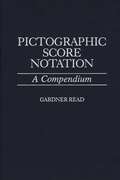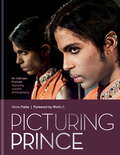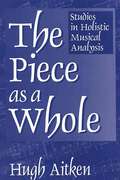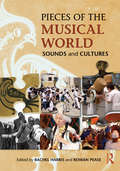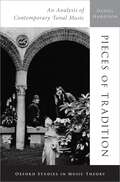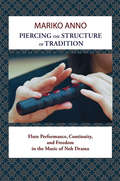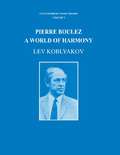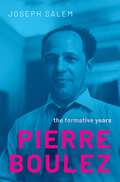- Table View
- List View
Piano Specimen Quick Studies: for ABRSM Diplomas (DipABRSM, LRSM, FRSM)
by AbrsmThis title contains valuable practice material for candidates preparing for the piano quick study in ABRSM Performance and Teaching Diploma exams. The book contains 10 studies at DipABRSM level and two each for LRSM and FRSM.
Piano Technique
by Walter Gieseking Karl LeimerThe volume presents two book by Walter Gieseking, foremost pianist of his generation, and his teacher for five years, Karl Leimer, that have long been sought after by students and teachers looking for a radical approach toward developing not only finger-technique but expression-technique. Emphasis throughout is on listening to one's self and proper understanding as the basis of proper technique for the piano.In book one, originally titled The Shortest Way to Pianistic Perfection, Gieseking and Leimer work with a series of piano works -- a study from Lebert and Stark, Bach's Two- and Three-Part Inventions in C, and Beethoven's Sonata in F Minor, Op. 2, No. 1. Before beginning to play, the student is asked to visualize each piece through silent reading. Through Leimer's instruction in this area the student soon discovers how to approach each piece as not merely a series of notes to memorize but as a coherent musical structure to understand. Following are instructions on natural interpretation, with consideration of touch, relaxation, and proper emphasis in the practice. Also given are notes on such topics as etudes, scales, broken chords, the trill, and tranquility.In book two, Rhythmics, Dynamics, Pedal and Other Problems of Piano Playing, Leimer carries his method of visualization further with a study of the Allemande from Bach's French Suite in E Major. Following are further exercises and practices for developing other pianistic technique with reference to works of other composers. Specific exercises which cover rhythmics, dynamics, and phrasing are designed so that they will benefit not only the pianist but also performers on other instruments. Extensive chapters on variety of touch and the pedal give a great number of techniques and exercises for extending the expressive and dynamic range.
Piano Time 1: (pdf)
by Pauline HallPiano Time 1 starts at the very beginning, with simple five-finger tunes for hands separately and together, many with duet parts. It gradually adds more notes and techniques to cover sharps and flats, simple scales and keys, and a range of dynamics and symbols.
Pianos And Politics In China: Middle-class Ambitions And The Struggle Over Western Music
by Richard Curt KrausIn China, a nation where the worlds of politics and art are closely linked, Western classical music was considered during the cultural revolution to be an imperialist intrusion, in direct conflict with the native aesthetic. In this revealing chronicle of the relationship between music and politics in twentieth-century China, Richard Kraus examines the evolution of China's ever-changing disposition towards European music and demonstrates the steady westernization of Chinese music. Placing China's cultural conflicts in global perspective, he traces the lives of four Chinese musicians and reflects on how their experiences are indicative of China's place at the furthest edge of an expanding Western international order.
Pianos, Toys, Music and Noise: Conversations with Steve Beresford
by Andy HamiltonSteve Beresford's polymathic activities have formed a prism for the UK improv scene since the 1970s. He is internationally known as a free improviser on piano, toy piano and electronics, composer for film and TV, and raconteur and Dadaist visionary. His résumé is filled with collaborations with hundreds of musicians and other artists, including such leading improvisers as Derek Bailey, Evan Parker and John Zorn, and he has given performances of works by John Cage and Christian Marclay. In this book, Beresford is heard in his own words through first-hand interviews with the author. Beresford provides compelling insight into an extensive range of topics, displaying the broad cultural context in which music is embedded. The volume combines chronological and thematic chapters, with topics covering improvisation and composition in jazz and free music; the connections between art, entertainment and popular culture; the audience for free improvisation; writing music for films; recording improvised music in the studio; and teaching improvisation. It places Beresford in the context of improvised and related musics – jazz, free jazz, free improvisation – in which there is growing interest.
Pianos, Toys, Music and Noise: Conversations with Steve Beresford
by Andy HamiltonSteve Beresford's polymathic activities have formed a prism for the UK improv scene since the 1970s. He is internationally known as a free improviser on piano, toy piano and electronics, composer for film and TV, and raconteur and Dadaist visionary. His résumé is filled with collaborations with hundreds of musicians and other artists, including such leading improvisers as Derek Bailey, Evan Parker and John Zorn, and he has given performances of works by John Cage and Christian Marclay. In this book, Beresford is heard in his own words through first-hand interviews with the author. Beresford provides compelling insight into an extensive range of topics, displaying the broad cultural context in which music is embedded. The volume combines chronological and thematic chapters, with topics covering improvisation and composition in jazz and free music; the connections between art, entertainment and popular culture; the audience for free improvisation; writing music for films; recording improvised music in the studio; and teaching improvisation. It places Beresford in the context of improvised and related musics – jazz, free jazz, free improvisation – in which there is growing interest.
Pick a Pocket Or Two: A History of British Musical Theatre
by Ethan MorddenFrom Gilbert and Sullivan to Andrew Lloyd Webber, from Julie Andrews to Hugh Jackman, from Half a Sixpence to Matilda, Pick a Pocket Or Two is the story of the British musical: where it began and how it developed. In Pick a Pocket Or Two, acclaimed author Ethan Mordden brings his wit and wisdom to bear in telling the full history of the British musical, from The Beggar's Opera (1728) to the present, with an interest in isolating the unique qualities of the form and its influence on the American model. To place a very broad generalization, the American musical is regarded as largely about ambition fulfilled, whereas the British musical is about social order. Oklahoma!'s Curly wins the heart of the farmer Laurey--or, in other words, the cowboy becomes a landowner, establishing a truce between the freelancers on horseback and the ruling class. Half a Sixpence, on the other hand, finds a working-class boy coming into a fortune and losing it to fancy Dans, whereupon he is reunited with his working-class sweetheart, his modest place in the social order affirmed. Anecdotal and evincing a strong point of view, the book covers not only the shows and their authors but the personalities as well--W. S. Gilbert trying out his stagings on a toy theatre, Ivor Novello going to jail for abusing wartime gas rationing during World War II, fabled producer C. B. Cochran coming to a most shocking demise for a man whose very name meant "classy, carefree entertainment." Unabashedly opinionated and an excellent stylist, author Ethan Mordden provokes as much as he pleases. Mordden is the preeminent historian of the form, and his book will be required reading for readers of all walks, from the most casual of musical theater goers to musical theater buffs to students and scholars of the form.
Pick a Pocket Or Two: A History of British Musical Theatre
by Ethan MorddenFrom Gilbert and Sullivan to Andrew Lloyd Webber, from Julie Andrews to Hugh Jackman, from Half a Sixpence to Matilda, Pick a Pocket Or Two is the story of the British musical: where it began and how it developed. In Pick a Pocket Or Two, acclaimed author Ethan Mordden brings his wit and wisdom to bear in telling the full history of the British musical, from The Beggar's Opera (1728) to the present, with an interest in isolating the unique qualities of the form and its influence on the American model. To place a very broad generalization, the American musical is regarded as largely about ambition fulfilled, whereas the British musical is about social order. Oklahoma!'s Curly wins the heart of the farmer Laurey--or, in other words, the cowboy becomes a landowner, establishing a truce between the freelancers on horseback and the ruling class. Half a Sixpence, on the other hand, finds a working-class boy coming into a fortune and losing it to fancy Dans, whereupon he is reunited with his working-class sweetheart, his modest place in the social order affirmed. Anecdotal and evincing a strong point of view, the book covers not only the shows and their authors but the personalities as well--W. S. Gilbert trying out his stagings on a toy theatre, Ivor Novello going to jail for abusing wartime gas rationing during World War II, fabled producer C. B. Cochran coming to a most shocking demise for a man whose very name meant "classy, carefree entertainment." Unabashedly opinionated and an excellent stylist, author Ethan Mordden provokes as much as he pleases. Mordden is the preeminent historian of the form, and his book will be required reading for readers of all walks, from the most casual of musical theater goers to musical theater buffs to students and scholars of the form.
Pick Up the Pieces: Excursions in Seventies Music
by John CorbettUnless you lived through the 1970s, it seems impossible to understand it at all. Drug delirium, groovy fashion, religious cults, mega corporations, glitzy glam, hard rock, global unrest—from our 2018 perspective, the seventies are often remembered as a bizarre blur of bohemianism and disco. With Pick Up the Pieces, John Corbett transports us back in time to this thrillingly tumultuous era through a playful exploration of its music. Song by song, album by album, he draws our imaginations back into one of the wildest decades in history. Rock. Disco. Pop. Soul. Jazz. Folk. Funk. The music scene of the 1970s was as varied as it was exhilarating, but the decade’s diversity of sound has never been captured in one book before now. Pick Up the Pieces gives a panoramic view of the era’s music and culture through seventy-eight essays that allow readers to dip in and out of the decade at random or immerse themselves completely in Corbett’s chronological journey. An inviting mix of skilled music criticism and cultural observation, Pick Up the Pieces is also a coming-of-age story, tracking the author’s absorption in music as he grows from age seven to seventeen. Along with entertaining personal observations and stories, Corbett includes little-known insights into musicians from Pink Floyd, Joni Mitchell, James Brown, and Fleetwood Mac to the Residents, Devo, Gal Costa, and Julius Hemphill. A master DJ on the page, Corbett takes us through the curated playlist that is Pick Up the Pieces with captivating melody of language and powerful enthusiasm for the era. This funny, energetic book will have readers longing nostalgically for a decade long past.
Pick Up the Pieces: Excursions in Seventies Music
by John CorbettUnless you lived through the 1970s, it seems impossible to understand it at all. Drug delirium, groovy fashion, religious cults, mega corporations, glitzy glam, hard rock, global unrest—from our 2018 perspective, the seventies are often remembered as a bizarre blur of bohemianism and disco. With Pick Up the Pieces, John Corbett transports us back in time to this thrillingly tumultuous era through a playful exploration of its music. Song by song, album by album, he draws our imaginations back into one of the wildest decades in history. Rock. Disco. Pop. Soul. Jazz. Folk. Funk. The music scene of the 1970s was as varied as it was exhilarating, but the decade’s diversity of sound has never been captured in one book before now. Pick Up the Pieces gives a panoramic view of the era’s music and culture through seventy-eight essays that allow readers to dip in and out of the decade at random or immerse themselves completely in Corbett’s chronological journey. An inviting mix of skilled music criticism and cultural observation, Pick Up the Pieces is also a coming-of-age story, tracking the author’s absorption in music as he grows from age seven to seventeen. Along with entertaining personal observations and stories, Corbett includes little-known insights into musicians from Pink Floyd, Joni Mitchell, James Brown, and Fleetwood Mac to the Residents, Devo, Gal Costa, and Julius Hemphill. A master DJ on the page, Corbett takes us through the curated playlist that is Pick Up the Pieces with captivating melody of language and powerful enthusiasm for the era. This funny, energetic book will have readers longing nostalgically for a decade long past.
Pick Up the Pieces: Excursions in Seventies Music
by John CorbettUnless you lived through the 1970s, it seems impossible to understand it at all. Drug delirium, groovy fashion, religious cults, mega corporations, glitzy glam, hard rock, global unrest—from our 2018 perspective, the seventies are often remembered as a bizarre blur of bohemianism and disco. With Pick Up the Pieces, John Corbett transports us back in time to this thrillingly tumultuous era through a playful exploration of its music. Song by song, album by album, he draws our imaginations back into one of the wildest decades in history. Rock. Disco. Pop. Soul. Jazz. Folk. Funk. The music scene of the 1970s was as varied as it was exhilarating, but the decade’s diversity of sound has never been captured in one book before now. Pick Up the Pieces gives a panoramic view of the era’s music and culture through seventy-eight essays that allow readers to dip in and out of the decade at random or immerse themselves completely in Corbett’s chronological journey. An inviting mix of skilled music criticism and cultural observation, Pick Up the Pieces is also a coming-of-age story, tracking the author’s absorption in music as he grows from age seven to seventeen. Along with entertaining personal observations and stories, Corbett includes little-known insights into musicians from Pink Floyd, Joni Mitchell, James Brown, and Fleetwood Mac to the Residents, Devo, Gal Costa, and Julius Hemphill. A master DJ on the page, Corbett takes us through the curated playlist that is Pick Up the Pieces with captivating melody of language and powerful enthusiasm for the era. This funny, energetic book will have readers longing nostalgically for a decade long past.
Pick Up the Pieces: Excursions in Seventies Music
by John CorbettUnless you lived through the 1970s, it seems impossible to understand it at all. Drug delirium, groovy fashion, religious cults, mega corporations, glitzy glam, hard rock, global unrest—from our 2018 perspective, the seventies are often remembered as a bizarre blur of bohemianism and disco. With Pick Up the Pieces, John Corbett transports us back in time to this thrillingly tumultuous era through a playful exploration of its music. Song by song, album by album, he draws our imaginations back into one of the wildest decades in history. Rock. Disco. Pop. Soul. Jazz. Folk. Funk. The music scene of the 1970s was as varied as it was exhilarating, but the decade’s diversity of sound has never been captured in one book before now. Pick Up the Pieces gives a panoramic view of the era’s music and culture through seventy-eight essays that allow readers to dip in and out of the decade at random or immerse themselves completely in Corbett’s chronological journey. An inviting mix of skilled music criticism and cultural observation, Pick Up the Pieces is also a coming-of-age story, tracking the author’s absorption in music as he grows from age seven to seventeen. Along with entertaining personal observations and stories, Corbett includes little-known insights into musicians from Pink Floyd, Joni Mitchell, James Brown, and Fleetwood Mac to the Residents, Devo, Gal Costa, and Julius Hemphill. A master DJ on the page, Corbett takes us through the curated playlist that is Pick Up the Pieces with captivating melody of language and powerful enthusiasm for the era. This funny, energetic book will have readers longing nostalgically for a decade long past.
Pick Yourself Up: Dorothy Fields and the American Musical (Broadway Legacies)
by Charlotte GreenspanIn a career that spanned nearly five decades, Dorothy Fields penned the words to more than four hundred songs, among them mega-hits such as "On the Sunny Side of the Street," "I Can't Give You Anything But Love," "The Way You Look Tonight," and "If My Friends Could See Me Now." While Fields's name may be known mainly to connoisseurs, her contributions to our popular culture--indeed, our national consciousness--have been remarkable. In Pick Yourself Up, Charlotte Greenspan offers the most complete, serious treatment of Fields's life and work to date, tracing her rise to prominence in a male-dominated world.
Pick Yourself Up: Dorothy Fields and the American Musical (Broadway Legacies)
by Charlotte GreenspanIn a career that spanned nearly five decades, Dorothy Fields penned the words to more than four hundred songs, among them mega-hits such as "On the Sunny Side of the Street," "I Can't Give You Anything But Love," "The Way You Look Tonight," and "If My Friends Could See Me Now." While Fields's name may be known mainly to connoisseurs, her contributions to our popular culture--indeed, our national consciousness--have been remarkable. In Pick Yourself Up, Charlotte Greenspan offers the most complete, serious treatment of Fields's life and work to date, tracing her rise to prominence in a male-dominated world.
Pictographic Score Notation: A Compendium (Non-ser.)
by Gardner ReadThis text provides the first comprehensive examination of pictographic notation. Pictographic musical notation represents the relevant instruments themselves rendered visually rather than verbally. Used most extensively in contemporary publications between the 1950s and 1980s, its popularity has waned in recent years. This expertly researched work displays the resourcefulness and inventiveness of 20th century orchestrators.Providing a detailed examination of pictographic score notation, this unique book passes over 60 years of contemporary composition and score publications. Divided into three sections, this work describes instrumental pictographs, stage diagrams, and pictographic performance directives. In addition to the thoroughly researched information and extensive technique illustrations, commentary on individual examples and frequent cross-referencing of related examples, differentiate this work from other journal articles and notation texts.
Picturing Prince: An Intimate Portrait
by Steve ParkePICTURING PRINCE sees the late icon's former art director, STEVE PARKE, revealing stunning intimate photographs of the singer from his time working at Paisley Park. At least half of the images in the book are exclusively published here for the first time; most other images in the book are rare to the public eye.Alongside these remarkable images are fifty engaging, poignant and often funny written vignettes by Parke, which reveal the very human man behind the reclusive superstar: from shooting hoops to renting out movie theatres at 4am; from midnight requests for camels to meaningful conversations that shed light on Prince as a man and artist. STEVE PARKE started working with Prince in 1988, after a mutual friend showed Prince some of Steve's photorealistic paintings. He designed everything from album covers and merchandise to sets for Prince's tours and videos. Somewhere in all of this, he became Paisley Park's official art director. He began photographing Prince at the request of the star himself, and continued to do so for the next several years. The images in this book are the arresting result of this collaboration.
The Piece as a Whole: Studies in Holistic Musical Analysis
by Hugh AitkenDesigned to serve music students at the college level, this informal approach to music theory relates the technical aspects of music with the expressive character of the art. The approach is holistic in the sense that it focuses on the interrelationships between the piece as heard by a socially conditioned listener and the notated, performed score: it aims to bridge the gap between the technical and expressive aspects of music. The composers addressed are: Bach, Mozart, Beethoven, Chopin, Schumann, Brahms, Wagner, Debussy, and Schoenberg. There are separate chapters on the problems of meaning in music and on the interdependence of aesthetic and ethical value-judgments. This novel and exciting approach to music theory will be a welcome addition to the musical analysis literature.
Pieces of the Musical World: Sounds and Cultures
by Rachel Harris Rowan PeasePieces of the Musical World: Sounds and Cultures is a fieldwork-based ethnomusicology textbook that introduces a series of musical worlds each through a single "piece." It focuses on a musical sound or object that provides a springboard from which to tell a story about a particular geographic region, introducing key aspects of the cultures in which it is embedded, contexts of performance, the musicians who create or perform it, the journeys it has travelled, and its changing meanings. A collaborative venture by staff and research ethnomusicologists associated with the Department of Music at SOAS, University of London, Pieces of the Musical World is organized thematically. Three broad themes: "Place", "Spirituality" and "Movement" help teachers to connect contemporary issues in ethnomusicology, including soundscape studies, music and the environment, the politics of identity, diaspora and globalization, and music and the body. Each of the book's fourteen chapters highlights a single musical "piece" broadly defined, spanning the range of "traditional," "popular", "classical" and "contemporary" musics, and even sounds which might be considered "not music." Primary sources and a web site hosting recordings with interactive listening guides, a glossary of musical terms and interviews all help to create a unique and dynamic learning experience of our musical world.
Pieces of the Musical World: Sounds And Cultures
by Rachel Harris Rowan PeasePieces of the Musical World: Sounds and Cultures is a fieldwork-based ethnomusicology textbook that introduces a series of musical worlds each through a single "piece." It focuses on a musical sound or object that provides a springboard from which to tell a story about a particular geographic region, introducing key aspects of the cultures in which it is embedded, contexts of performance, the musicians who create or perform it, the journeys it has travelled, and its changing meanings. A collaborative venture by staff and research ethnomusicologists associated with the Department of Music at SOAS, University of London, Pieces of the Musical World is organized thematically. Three broad themes: "Place", "Spirituality" and "Movement" help teachers to connect contemporary issues in ethnomusicology, including soundscape studies, music and the environment, the politics of identity, diaspora and globalization, and music and the body. Each of the book's fourteen chapters highlights a single musical "piece" broadly defined, spanning the range of "traditional," "popular", "classical" and "contemporary" musics, and even sounds which might be considered "not music." Primary sources and a web site hosting recordings with interactive listening guides, a glossary of musical terms and interviews all help to create a unique and dynamic learning experience of our musical world.
Pieces of Tradition: An Analysis of Contemporary Tonal Music (Oxford Studies in Music Theory)
by Daniel HarrisonThis book is about how music "in a key" is composed. Further, it is about how such music was composed when it was no longer compulsory to do so, starting a few years before the First World War. In an eclectic journey through the history of compositional technique, Daniel Harrison contends that the tonal system did not simply die out with the dawn of twentieth century, but continued to supplement newer techniques as a compelling means of musical organization, even into current times. Well-known art music composers such as Bartok, Hindemith, Prokofiev, and Messiaen are represented alongside composers whose work moves outside the standard boundaries of art music: Leonard Bernstein, Murice Duruflé, Frank Martin, Xiaoyong Chen. Along the way, the book attends to military bugle calls, a trailer before a movie feature, a recomposition of a famous piece by Arnold Schoenberg, and the music of Neil Diamond, David Shire, and Brian Wilson. A celebration of the awesome variety of musical expressions encompassed in what is called tonal music, Pieces of Tradition is a book for composers seeking ideas and effects, music theorists interested in its innovations, and all those who practice the analysis of composition in all its modern and traditional variations.
Pieces of Tradition: An Analysis of Contemporary Tonal Music (Oxford Studies in Music Theory)
by Daniel HarrisonThis book is about how music "in a key" is composed. Further, it is about how such music was composed when it was no longer compulsory to do so, starting a few years before the First World War. In an eclectic journey through the history of compositional technique, Daniel Harrison contends that the tonal system did not simply die out with the dawn of twentieth century, but continued to supplement newer techniques as a compelling means of musical organization, even into current times. Well-known art music composers such as Bartok, Hindemith, Prokofiev, and Messiaen are represented alongside composers whose work moves outside the standard boundaries of art music: Leonard Bernstein, Murice Duruflé, Frank Martin, Xiaoyong Chen. Along the way, the book attends to military bugle calls, a trailer before a movie feature, a recomposition of a famous piece by Arnold Schoenberg, and the music of Neil Diamond, David Shire, and Brian Wilson. A celebration of the awesome variety of musical expressions encompassed in what is called tonal music, Pieces of Tradition is a book for composers seeking ideas and effects, music theorists interested in its innovations, and all those who practice the analysis of composition in all its modern and traditional variations.
Piercing the Structure of Tradition: Flute Performance, Continuity, and Freedom in the Music of Noh Drama
by Mariko AnnoWhat does freedom sound like in the context of traditional Japanese theater? Where is the space for innovation, and where can this kind of innovation be located in the rigid instrumentation of the Noh drama? In Piercing the Structure of Tradition, Mariko Anno investigates flute performance as a space to explore the relationship between tradition and innovation. This first English-language monograph traces the characteristics of the Noh flute (nohkan), its music, and transmission methods and considers the instrument's potential for development in the modern world. Anno examines the musical structure and nohkan melodic patterns of five traditional Noh plays and assesses the degree to which Issō School nohkan players maintain to this day the continuity of their musical traditions in three contemporary Noh plays influenced by Yeats. Her ethnographic approach draws on interviews with performers and case studies, as well as her personal reflection as a nohkan performer and disciple under the tutelage of Noh masters. She argues that traditions of musical style and usage remain influential in shaping contemporary Noh composition and performance practice, and the existing freedom within fixed patterns can be understood through a firm foundation in Noh tradition.
Pierre Boulez: A World of Harmony (Contemporary Music Studies #2)
by Lev KoblyakovFirst published in 1994. Routledge is an imprint of Taylor & Francis, an informa company.
Pierre Boulez: A World of Harmony (Contemporary Music Studies)
by Lev KoblyakovFirst published in 1994. Routledge is an imprint of Taylor & Francis, an informa company.
Pierre Boulez: The Formative Years
by Joseph SalemAs an integral figure in twentieth-century music, Pierre Boulez innovated new musical ideas through extraordinary creative processes. His formative years tracked his compositional development from his confrontations with serialism to drafting one of his major works, Pli selon pli, in the early 1960s. Part biography, part survey, Pierre Boulez: The Formative Years situates Boulez and his compositions among a complex network of influences. To best understand Boulez's creative process, author Joseph R. Salem organizes the book into three parts. First, Boulez's early life, training, and education provide biographical context for his career. Salem provides a fresh, revisionist perspective of the composer's life by drawing upon a mix of primary and secondary sources. Second, the brunt of the biography situates Boulez's musical works and experimentation among a host of contextual contexts. In place of scores and complicated musical analyses, Salem employs sketches as a visual metonym. The sketches denote Boulez's continual ability to self-reform, accept feedback from his peers, mentors, and family members, and revitalize old material. Third, Boulez's legacy is associated with contemporaneous aesthetic movements and artistic challenges. While his creative processes undoubtedly influenced music today, Boulez remains a controversial, even taboo, figure among contemporary musicians and audiences. A book that both celebrates and critiques its subject, The Formative Years urges a reconsideration of narratives and discussions surrounding Boulez's life and works.
